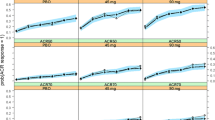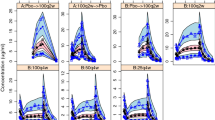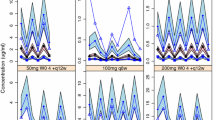Abstract
Improving the quality of exposure–response modeling is important in clinical drug development. The general joint modeling of multiple endpoints is made possible in part by recent progress on the latent variable indirect response (IDR) modeling for ordered categorical endpoints. This manuscript aims to investigate, when modeling a continuous and a categorical clinical endpoint, the level of improvement achievable by joint modeling in the latent variable IDR modeling framework through the sharing of model parameters for the individual endpoints, guided by the appropriate representation of drug and placebo mechanism. This was illustrated with data from two phase III clinical trials of intravenously administered mAb X for the treatment of rheumatoid arthritis, with the 28-joint disease activity score (DAS28) and 20, 50, and 70 % improvement in the American College of Rheumatology (ACR20, ACR50, and ACR70) disease severity criteria were used as efficacy endpoints. The joint modeling framework led to a parsimonious final model with reasonable performance, evaluated by visual predictive check. The results showed that, compared with the more common approach of separately modeling the endpoints, it is possible for the joint model to be more parsimonious and yet better describe the individual endpoints. In particular, the joint model may better describe one endpoint through subject-specific random effects that would not have been estimable from data of this endpoint alone.




Similar content being viewed by others

References
Felson DT, Anderson JJ, Boers M et al (1995) American College of Rheumatology. Preliminary definition of improvement in rheumatoid arthritis. Arthritis Rheum 38(6):727–735
Hu C (2014) Exposure-response modeling of clinical end points using latent variable indirect response models. CPT: Pharmacomet Syst Pharmacol 3:e117. doi:10.1038/psp.2014.15
Dayneka NL, Garg V, Jusko WJ (1993) Comparison of four basic models of indirect pharmacodynamic responses. J Pharmacokinet Biopharm 21(4):457–478
Hutmacher MM, Krishnaswami S, Kowalski KG (2008) Exposure-response modeling using latent variables for the efficacy of a JAK3 inhibitor administered to rheumatoid arthritis patients. J Pharmacokinet Pharmacodyn 35:139–157
Hu C, Xu Z, Rahman MU, Davis HM, Zhou H (2010) A latent variable approach for modeling categorical endpoints among patients with rheumatoid arthritis treated with golimumab plus methotrexate. J Pharmacokinet Pharmacodyn 37(4):309–321
Hu C, Xu Z, Mendelsohn A, Zhou H (2013) Latent variable indirect response modeling of categorical endpoints representing change from baseline. J Pharmacokinet Pharmacodyn 40(1):81–91
Hu C, Szapary PO, Yeilding N, Zhou H (2011) Informative dropout modeling of longitudinal ordered categorical data and model validation: application to exposure-response modeling of physician’s global assessment score for ustekinumab in patients with psoriasis. J Pharmacokinet Pharmacodyn 38(2):237–260
Hu C, Yeilding N, Davis HM, Zhou H (2011) Bounded outcome score modeling: application to treating psoriasis with ustekinumab. J Pharmacokinet Pharmacodyn 38(4):497–517
Ma L, Zhao L, Xu Y, Yim S, Doddapaneni S, Sahajwalla CG, Wang Y, Ji P (2014) Clinical endpoint sensitivity in rheumatoid arthritis: modeling and simulation. J Pharmacokinet Pharmacodyn 41(5):537–543. doi:10.1007/s10928-014-9385-x
Ringold S, Chon Y, Singer NG (2009) Associations between the American College of Rheumatology pediatric response measures and the continuous measures of disease activity used in adult rheumatoid arthritis. Arthritis Rheum 60(12):3776–3783
Laffont CM, Vandemeulebroecke M, Concordet D (2014) Multivariate analysis of longitudinal ordinal data with mixed effects models, with application to clinical outcomes in osteoarthritis. J Am Stat Assoc 109(507):955–966
Hu C, Szapary PO, Mendelsohn AM, Zhou H (2014) Latent variable indirect response joint modeling of a continuous and a categorical clinical endpoint. J Pharmacokinet Pharmacodyn 41:335–349
Beal SL, Sheiner LB, Boeckmann A, Bauer RJ (2009) NONMEM user’s guides (1989-2009). Icon Development Solutions, Ellicott City
Weinblatt ME, Bingham CO, Mendelsohn AM, Kim L, Mach M, Lu J, Baker D, Westhovens R (2012) Intravenous golimumab is effective in patients with active rheumatoid arthritis despite methotrexate therapy with responses as early as week 2: results of the phase 3, randomised, multicentre, double-blind, placebo-controlled GO-FURTHER trial. Ann Rheum Dis 72:381–389
Kremer J, Ritchlin C, Mendelsohn A, Baker D, Kim L, Xu Z, Han J, Taylor P (2010) Golimumab, a new human anti-TNFalpha antibody, administered intravenously in patients with active rheumatoid arthritis: 48-Week efficacy and safety results of a phase 3, randomized, double-blind, placebo-controlled study. Arthritis Rheum. doi:10.1002/art.27348
Hu C, Zhou H (2008) An improved approach for confirmatory phase III population pharmacokinetic analysis. J Clin Pharmacol 48:812–822
Hutmacher MM, French JL (2011) Extending the latent variable model for extra correlated longitudinal dichotomous responses. J Pharmacokinet Pharmacodyn 38:833–859
Hutmacher MM, Mukherjee D, Kowalski KG, Jordan DC (2005) Collapsing mechanistic models: an application to dose selection for proof of concept of a selective irreversible antagonist. J Pharmacokinet Pharmacodynam 32:501–520
Acknowledgments
The authors thank two anonymous reviewers for their insightful and constructive suggestions.
Funding
This research was funded by Janssen Research and Development, LLC.
Author information
Authors and Affiliations
Corresponding author
Rights and permissions
About this article
Cite this article
Hu, C., Zhou, H. Improvement in latent variable indirect response joint modeling of a continuous and a categorical clinical endpoint in rheumatoid arthritis. J Pharmacokinet Pharmacodyn 43, 45–54 (2016). https://doi.org/10.1007/s10928-015-9453-x
Received:
Accepted:
Published:
Issue Date:
DOI: https://doi.org/10.1007/s10928-015-9453-x



